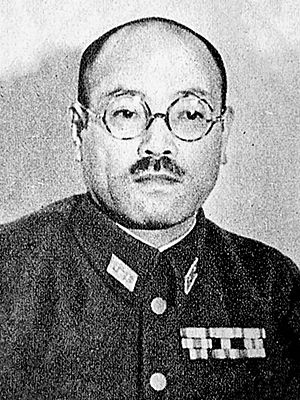Takashi Sakai facts for kids
Quick facts for kids
Takashi Sakai
|
|
|---|---|
|
酒井隆
|
|

Lt. General Takashi Sakai
|
|
| Governor of Hong Kong under Japanese occupation |
|
| In office December 25, 1941 – February 20, 1942 Serving with Masaichi Niimi
|
|
| Monarch | Shōwa |
| Prime Minister | Hideki Tōjō |
| Preceded by | Sir Mark Aitchison Young |
| Succeeded by | Rensuke Isogai |
| Personal details | |
| Born | October 18, 1887 Kamo District, Hiroshima Prefecture, Japan |
| Died | September 30, 1946 (aged 58) Nanjing, Jiangsu, Republic of China |
| Cause of death | Died after a trial |
| Alma mater | Army War College |
| Military service | |
| Allegiance | |
| Branch/service | |
| Years of service | 1908-1943 |
| Rank | |
| Commands | IJA 26th Division, IJA 4th Army, Southern China Area Army, China Expeditionary Army, Central District Army, IJA Third Area Army |
| Battles/wars | Second Sino-Japanese War World War II |
Takashi Sakai (酒井 隆, Sakai Takashi, 18 October 1887 – 30 September 1946) was a high-ranking officer in the Imperial Japanese Army. He served during World War II. He is best known for his time as the Governor of Hong Kong when it was under Japanese control.
Contents
Early Life and Military Training
Takashi Sakai was born on October 18, 1887. His birthplace was in the Kamo District, Hiroshima, Japan. This area is now part of Hiroshima city.
He attended special military schools in Kobe and Osaka. These schools helped prepare him for a career in the army. In 1908, he finished his studies at the Imperial Japanese Army Academy. After graduating, he joined the IJA 28th Infantry Regiment. He also completed training at the Army Staff College.
Military Career in China
Sakai spent a lot of his military career in China. In 1928, he was in Jinan, Shandong Province. He was part of the IJA 12th Infantry Regiment during an event called the Jinan Incident.
From 1929 to 1932, he was stationed in Tianjin. In 1932, Sakai was promoted to the rank of colonel. He then worked in military intelligence for the Imperial Japanese Army.
From 1934 to 1935, Sakai was the Chief of Staff for the Japanese army in China. During this time, he was involved in several conflicts. These events led to an agreement with the Chinese government. This agreement, called the He–Umezu Agreement, gave Japan more control over Hebei Province.
Sakai became a major general in 1937. He was then put in charge of the IJA 28th Infantry Brigade. By 1939, he was promoted to lieutenant general. He worked in different departments dealing with Asia and Mongolia. In 1940, he returned to Japan for a short time.
Role in World War II
In November 1941, Sakai was the commander of the IJA 23rd Army. This army was located in Canton, China. He received orders to capture Hong Kong. He was given a strict deadline of 10 days to complete this mission.
On December 8, 1941, Japanese forces led by Sakai invaded Hong Kong. This happened just hours after the attack on Pearl Harbor. The battle for Hong Kong, known as the Battle of Hong Kong, was tougher than Sakai expected. He had to ask for more time to complete his mission.
Sir Mark Young, who was the Governor of Hong Kong at the time, surrendered all British forces. This happened on Christmas Day, after 18 days of fighting.
Sakai served as the Japanese Governor of Hong Kong for a short period. He held this position until February 20, 1942. After this, he was called back to Japan. He officially retired from active military service in 1943.
Later Life and Trial
After World War II ended, Takashi Sakai was taken into custody. This happened at the request of the Chinese government. He was sent to China to face a trial.
He was found responsible for actions that harmed civilians during the war. On August 27, 1946, he was found guilty at the Nanjing War Crimes Tribunal. Takashi Sakai died on September 30, 1946, following this trial.
Images for kids


